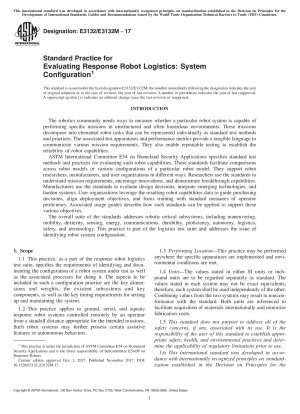ASTM E3132/E3132M-17
Standard Practice for Evaluating Response Robot Logistics: System Configuration
- Standard No.
- ASTM E3132/E3132M-17
- Release Date
- 2017
- Published By
- American Society for Testing and Materials (ASTM)
- Latest
- ASTM E3132/E3132M-17
- Scope
-
5.1 These basic requirements for response robots that help enhance the safety and effectiveness of responders or soldiers include: the robots are designed to be remotely operated from safe standoff distances, deployable at operational tempos, capable of operating in complex environments, sufficiently hardened against harsh environments, reliable and field serviceable, durable or cost-effectively disposable, and equipped with operational safeguards.
5.2 This practice aligns user expectations with actual capabilities to understand the inherent trade-offs in deployable systems at any given cost. For example, a design issue of the number of batteries to be packed on a robot could affect the desired weight, endurance, or cost. Appropriate levels of understanding can help ensure that requirement specifications are articulated within the limit of current capabilities.
5.3 This practice provides a tangible representation of essential robot capabilities with quantifiable measures of performance. It facilitates communication among communities of robot users and manufacturers. As such, this practice can be used to help:
5.3.1 Inspire technical innovation and guide developers toward implementing the combinations of capabilities necessary to perform essential mission tasks.
5.3.2 Measure and compare essential robot capabilities. This practice can help establish the reliability of the system to perform specified tasks, highlight break-through capabilities, and encourage hardening of developmental systems.
5.3.3 Inform purchasing decisions, conduct acceptance testing, and align deployment objectives with statistically significant robot capabilities data captured through repeated testing and comparison of quantitative results.
5.3.4 Focus operator training and measure proficiency as a repeatable practice task that exercises actuators, sensors, and operator interfaces. The practice can help capture and compare quantitative scores even within uncontrolled environmental variables and, in turn, help develop, maintain, measure, and track very perishable skills over time and enable comparisons across squads, regions, or national averages.
5.4 Although this practice is scoped for homeland security applications, it could be much more wildly applicable. However, it shall be the responsibilities of the respective practitioners to verify the extents of applicability of this practice to their domains.
1.1 This practice, as a part of the response robot logistics test suite, specifies the requirements of identifying and documenting the configuration of a robot system under test as well as the associated processes for doing it. The aspects to be included in such a configuration practice are the key dimensions and weights, the existent subsystems and key components, as well as the key timing requirements for setting up and maintaining the system.
1.2 This practice applies to ground, aerial, and aquatic response robot systems controlled remotely by an operat......
ASTM E3132/E3132M-17 Referenced Document
- ASTM E2521 Standard Terminology for Evaluating Response Robot Capabilities
- ASTM E2592 Standard Practice for Evaluating Response Robot Capabilities: Logistics: Packaging for Urban Search and Rescue Task Force Equipment Caches
- ASTM E2830 Standard Test Method for Evaluating the Mobility Capabilities of Emergency Response Robots Using Towing Tasks: Grasped Sleds
- ASTM E2854 Standard Test Method for Evaluating Emergency Response Robot Capabilities: Radio Communication: Line-of-Sight Range
- ASTM E2855 Standard Test Method for Evaluating Emergency Response Robot Capabilities: Radio Communication: Non-Line-of-Sight Range
ASTM E3132/E3132M-17 history
- 2017 ASTM E3132/E3132M-17 Standard Practice for Evaluating Response Robot Logistics: System Configuration

Copyright ©2024 All Rights Reserved